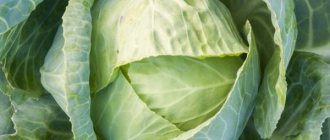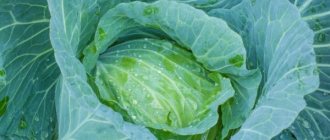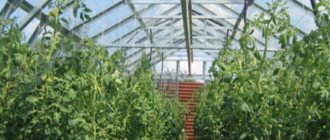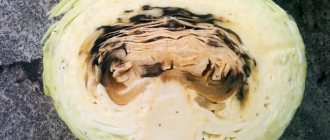June cabbage is an old variety that got its name due to its early ripening. Heads of cabbage can be harvested as early as June; they are indispensable for the first vitamin salads. Despite a number of disadvantages, such as a tendency to crack and unsuitability for pickling, the variety has not lost popularity for many years.
| Landing location | Ripening time | View | Purpose | Origin | Maturation period | Weight |
| Open ground | Early ripening | White cabbage | Fresh, Cooking | Variety | 90-117 | 0,9-2,5 |
Origin of the June cabbage variety
The June cabbage variety was bred by the domestic research center for vegetable growing. As the basis for the new variety, we took an already existing and no less famous variety – Gribovsky 147.
The original culture was crossed with the early Dietmar 2399 and improved in various ways. As a result of strict selection, the first specimens of a new cabbage variety appeared in 1967. But he was not officially recognized immediately. The variety was included in the state register only in 1971.
It is worth noting that quite often on bags of seeds of this cabbage variety, in addition to the standard name, you can also find the inscription “June 3200”. Both names imply the same variety, and the numerical value at the end refers only to the numbering that was used during the breeding of the crop.
Description and characteristics
June cabbage is one of the early ripening varieties. The total period of plant development is 3–3.5 months. From the moment the seedlings are planted in open ground until the heads fully mature, it takes about 60–65 days.
A mature head of such cabbage has the following characteristics:
- density on a generally accepted scale is 4 points;
- the shape is completely round;
- the average diameter varies between 40–45 cm;
- the upper leaves are colored light green;
- the core has a lighter yellowish tint;
- the stalk of the head of cabbage is elongated, internal;
- weight, depending on size, ranges from 1 to 2.4 kg.
Cabbage leaves of this variety are valued for their juiciness and good taste. The average crop yield is 360 centners per hectare. But during testing it was found that with proper care and on fertile soil, this figure increases to 630-640 centners.
Why are different planting dates used?
Of course, it’s not for nothing that this cabbage is called June cabbage. The name itself suggests that it can be consumed at the very beginning of summer.
Attention! The characteristics of the variety state that its growing season can vary from 90 to 110 days.
This means the number of days that pass from the emergence of seedlings to the formation of heads of cabbage. Thus, if you want to try this cabbage already in June, then you need to sow it as seedlings as early as possible in the spring, around the beginning of March.
In general, there is nothing wrong with this, given that it is during these periods that gardeners sow peppers and tomatoes for seedlings. But growing cabbage seedlings has its own characteristics and requires the creation of completely different conditions compared to tomatoes and peppers. In addition, when planting in the ground, it is desirable that the age of the seedlings does not exceed 45-50 days.
When sowing cabbage for seedlings in early March, you will need to plant it in a permanent place in the second half of April, otherwise the seedlings risk overgrowing, which will negatively affect its fruiting. At least you won’t have to wait for the early heads of cabbage. But in most regions of Russia in the second half of April, very significant frosts are still possible, which even such a cold-resistant plant as cabbage cannot tolerate. This means that you will need to take additional care of thoroughly covering the cabbage planted in the ground.
If you are willing to go to a lot of extra trouble to get a super early cabbage harvest, then everything is in your hands.
Most gardeners often do not have the opportunity to provide cabbage with such conditions, especially since besides it, there are a thousand different things in the garden that require attention during this hot period.
“When should I plant cabbage in this case?” - you ask.
Advice! More experienced gardeners traditionally sow early June cabbage in the second half of March to obtain the earliest possible harvest with minimal effort.
In this case, seedlings can be planted in the ground in early to mid-May. These dates are traditional for planting cabbage seedlings in open ground for most regions of Russia. Moreover, the ancient Russian agricultural calendar even includes two special dates dedicated to planting cabbage seedlings. In 2021 it will be May 8-12 and May 19-24. Cabbage seedlings will no longer require any additional measures to protect them from cold weather. And under favorable care conditions, you will still be able to try the first heads of cabbage in June, but only at the very end.
There is also a category of gardeners who are not at all interested in sowing dates and for them the question “when to plant cabbage seedlings” is not particularly important. For them, the main thing is to put in as little effort as possible and still get a high-quality harvest. In this case, the easiest way is to sow cabbage seeds in a greenhouse or under film covers in April or even early May, where the seedlings will develop in the most optimal way for themselves, even without special care.
At the end of May, it is usually transplanted to a permanent place of residence in the beds and cared for in the traditional way: watering, fertilizing, and pest control. True, in this case the harvest is obtained only by August, but without much effort.
Attention! This method is ideal for growing mid-season varieties, but some people use it for June cabbage too.
Watch the video, which once again explains all the subtleties associated with the timing of planting cabbage seedlings:
Advantages and disadvantages of the variety
The June cabbage variety is popular among summer residents due to its wide list of advantages. The main ones among them are the following:
- rapid ripening of heads of cabbage, which are ready for consumption by mid-June;
- the possibility of productive cultivation in the climatic conditions of most post-Soviet states;
- yield is 95–97%;
- the crop in the form of seedlings tolerates frosts down to -2 degrees, for mature heads of cabbage even a decrease to -4 degrees is harmless;
- cabbage is not susceptible to damage from the cabbage fly;
- frequent and abundant watering during the ripening period of the heads increases their juiciness and does not lead to cracking;
- average resistance to diseases characteristic of all cruciferous crops.
It is also worth noting that almost all planted heads ripen at the same time, which greatly simplifies the harvesting and sale of the vegetable.
But like any other variety, in addition to obvious advantages, June also has some disadvantages. The main ones are the following:
- unsuitability for storage in open ground in the garden;
- short shelf life of heads after harvest;
- susceptibility of the crop to the appearance of clubroot.
June cabbage harvest
It is also worth noting that in addition to its general unsuitability for storage, such a vegetable will not be preserved in pickled form. It is usually consumed only fresh.
Features of growing June cabbage
Good yields of this crop are obtained only if the basic growing conditions are met. Moreover, over more than 40 years of existence of the variety, clear recommendations have been formed on the timing of sowing, planting seedlings and caring for seedlings.
Sowing seeds for seedlings
The timing of sowing the seeds of this crop for seedlings directly depends on the weather conditions of the region and the expected time of planting the seedlings. In the south, winter cold recedes earlier. Therefore, sowing begins around the end of February, so that by the end of April the seedlings are ready for planting in the ground. In the northern regions, seeds are sown in early to mid-April, since with earlier sowing, the ground will be too cold by the time the plants are planted.
Experienced gardeners say that sowing can be postponed for 5–7 days. But you shouldn’t wait any longer, since in the warmth the seedlings stretch upward and do not form heads of cabbage.
Before planting, the seeds require some preparation. And the main stage here is disinfection. The procedure is carried out in one of the following ways:
- Soaking in a solution of potassium permanganate. For treatment, prepare a solution with a concentration of 1%. Pour the seeds into the liquid for 15 minutes. Then they are allowed to dry and planted.
- Contrast heat treatment. In this case, the seeds are first kept for 15 minutes in water at a temperature of 45–55 degrees. After this, place it in water at a temperature of 5 degrees for 15 minutes. After drying, the seed is ready for planting.
- Use of vitamin and mineral supplements. This treatment involves soaking the seeds in a solution of Fitosporin, Ecosil or similar preparations.
Plant the seed in peat pots, ceramic or cardboard boxes. They must have drainage holes at the bottom. Before sowing, the soil is mixed with special substrates.
Important! Planting in a box is carried out in rows. In this case, each seed is deepened by 1 cm, the distance between the seeds in the row is also 1 cm, a space of 3 cm is made between the rows. Part of the seed is left in reserve and sown on previously made rows every two days.
Seedling care
The seedlings will hatch already on the 5-6th day after planting. At this time, they are also provided with special care, including the following steps:
- Removing excess shoots. To increase the nutrient area, all seedlings are thinned out.
- Primary hardening. It is carried out at a temperature of 10 degrees. All seedlings are placed in a room with the specified temperature conditions for a period of 10–12 days. This procedure prepares the plant for possible unfavorable conditions.
- Rest. At the end of the first hardening, the seedlings are allowed to rest. The container with the plants is brought into a warm room. Here they are left for several hours, after which they are placed in boxes at a distance of 10–12 cm from each other. Alternatively, you can take separate pots for each seedling. The rest phase lasts for 3 days. At the same time, the vegetation is watered every day.
- Secondary hardening. At the end of preparation, the seedlings are again hardened in the manner indicated above.
After all the procedures have been completed, the seedlings become more resilient and are ready for planting in open ground. In addition, this approach avoids pulling out the sprouts.
Transplantation into the ground
Seedlings are planted approximately 40–50 days after sowing. The main sign of readiness for planting is the presence of several fully formed cabbage leaves in the plants and a height of 10–12 cm.
Transplanting June cabbage seedlings into the ground
It is advisable to plant the plant the day before it rains. Carry out the procedure in the evening, select those areas where potatoes, tomatoes, pumpkins or onions grew last season. After other cruciferous vegetables, cabbage is planted on the same soil no earlier than 4 years later. Additionally, it is recommended to carry out preliminary liming of the soil. Phosphates and humus are also added to the soil.
The landing procedure itself consists of the following steps:
- Holes are dug in the selected area, focusing on a 40x50 cm pattern.
- The box with seedlings is filled with water.
- Each individual sprout is removed from the soil with a lump of soil.
- Such a lump is placed in the hole and sprinkled with part of the extracted soil.
- Then the ground is watered and the remaining layer of dry soil is added.
Attention! If necessary, frames are placed on top of the rows and covered with film.
Landing
In the southern regions, you can plant seeds directly in open ground or using seedlings. In the south, seedlings are sown in mid-March, in the Urals or Siberia - in mid-April directly under the film or in the greenhouse. By the time of transplanting into the ground, the bushes should be 30-35 days old. They are vulnerable to frost.
Before planting, the seeds are hardened and disinfected:
- Place in hot water (+50 degrees) and leave for half an hour.
- Place in a cold place for a few minutes.
- Soak in a solution of potassium permanganate 1% for 20 minutes.
Then rinse with running water.
Seedlings are sown in a nutrient substrate prepared in one of the following ways:
- 7 parts peat, 2 parts earth and 1 part sand;
- 4 parts humus, 1 part earth and 0.3 parts mullein;
- 2 parts earth and 1 part humus.
The substrate must be disinfected, especially if humus was used in it. To kill bacteria and viruses, the soil is calcined in the oven at +100 degrees for 20 minutes, frozen or poured with boiling water with fungicides.
Add a glass of ash and 2-3 tbsp to a bucket of mixture. complex mineral fertilizers.
It is better to plant in individual pots so that the roots do not suffer when picking. When sowing in common boxes in moist soil, grooves 0.5-1 cm deep are made at a distance of 5-6 cm from each other. Having planted the seeds, they are watered, covered with film and placed in a warm place.
Once full shoots appear, they are kept cool (+6-10 degrees) for 4-7 days. This will protect against pulling. Then provide a temperature of +14-16.
Water as needed. They dive in the phase of the first true leaf. If the seeds were planted in individual containers, picking is not necessary. Then the seedlings are thinned out, leaving the strongest.
A week later, the bushes are fed with a solution of 40 g of superphosphate, 20 g of ammonium nitrate and 10 g of potassium chloride per bucket of water.
They are placed on the bed according to a 50 by 50 or 40 by 40 cm pattern.
Caring for June cabbage
June cabbage tolerates spring cold well, but requires compliance with certain care rules. Timely watering, fertilizing and treating plants against pests will allow you to achieve maximum productivity.
Watering
Since moisture evaporates extremely quickly from large plant leaves, cabbage is watered quite often. After planting for 14 days, watering is carried out in the morning or evening three times a week. In this case, water should saturate the soil to 40 cm, which corresponds to a liquid consumption of 8 liters per square meter.
After the specified time, you should switch to one watering per week. In this case, water consumption is increased to 12 liters per square meter. Additionally, throughout the entire period of head formation, on particularly hot days, you should carefully spray the leaves with water. They do this in the evening, when the heat subsides.
Watering is carried out in one of two ways:
- Sprinkling (more preferable).
- By adding liquid to the root zone of the plant.
After the procedure is completed, the top layer of soil is fluffed up so that air can pass through better.
Attention! Watering is completely stopped two weeks before the planned cutting of the heads.
Feeding
Fertilizing can significantly accelerate the growth of cabbage and promotes its proper development. At the initial stage of plant growth, two weeks after transplanting into open ground, nitrogen-rich compounds are actively used. The most suitable additive in this regard would be liquid mullein, a solution of which is prepared in the proportion of 1 glass per 10 liters of water. Urea diluted with water (30 g per 10 l) also gives good results. Fertilize the crop during watering.
With the beginning of the formation of heads of cabbage, the approach is changed. During this period, the plant needs large amounts of phosphorus and potassium. To replenish them, ordinary ash is often used. It is added to the soil at the rate of 0.5 kg of substance per square meter of soil. Of the ready-made formulations, nitroammophoska is recommended. If it is used, 30 g of the composition is allocated to the same area.
For periodic feeding, an infusion of dandelion, nettle and woodlice is used. Large volumes of such vegetation are crushed into a barrel and filled with water. The finished infusion is diluted again with water and applied to the soil during watering.
Protection from pests and diseases
June cabbage is subject to frequent attacks from cabbageweed, aphids and some other pests. To combat them, special formulations are used, which require both a universal and an individual approach for each specific case. In the first option, the drug Fitoverm has proven itself well, the solution of which is sprayed on the crop in accordance with the instructions indicated on the packaging.
Cabbage butterfly
The most common cultural diseases include the following:
- Fusarium wilt. This disease manifests itself in stunted growth, yellowing and falling leaves. There is no effective treatment available. Therefore, the affected vegetation is removed from the site along with a lump of soil.
- Kila. It is accompanied by the appearance of a tumor on the roots of cabbage, which interferes with the development of the plant. Involves removing diseased specimens and disinfecting the soil.
- Blackleg. It manifests itself as blackening and rotting of the plant stem. When it is detected, diseased stems are removed from the ground, and healthy ones are planted, having previously been treated with Bordeaux mixture.
Timing of harvesting and storage of heads of cabbage
The heads are collected from June 7 to June 25 (depending on the region). Vegetables with tightly knit heads and yellowed lower leaves must be harvested. The cut is made across the stalk at a distance of 3–4 cm from the base of the head. In this case, the procedure itself is planned for the morning.
Unlike other cabbage varieties, this one is not stored on the roots. Therefore, all ripe heads of cabbage are cut off immediately. In cool rooms, such a crop will last no more than 14–16 days, after which it begins to rot.
Agricultural technology
Watering cabbage
Cabbage will grow well only with regular watering.
After planting the seeds, the crop cannot be flooded. It is necessary to “accustom” the plant to receive water from the depths. With heavy watering, the crop will “get used” to the fact that a strong root system is not needed to receive moisture.
After transplanting the seedling into the OG, it is not watered for 5 days. This is necessary so that the plant takes root well. Next, watering is carried out systematically, once a week, until the heads of cabbage are set. When the heads of cabbage begin to set, the cabbage is watered 2-3 times a week in a volume of 3-4 liters per bush.
A month before harvesting, the intensity of watering is reduced, and 2 weeks later it is completely stopped so that the heads of cabbage do not crack.
Water the vegetable only with warm, settled water, preferably in the early morning or evening. If a drip irrigation system is used, then the time of day does not play any role when watering, since the water gets under the root without touching the foliage.
Loosening
Loosening plays a vital role in caring for white cabbage. This procedure is carried out to saturate the soil with oxygen and remove excess water from the soil. In addition, when loosening, weeds are removed from the roots.
We recommend reading: Description of the cabbage variety Kuharka F1
After watering, and in the case of cabbage they are very frequent, the soil becomes significantly compacted; loosening quickly solves this problem.
Loosening is carried out according to the following plan:
- A week after planting the seedlings in the exhaust gas, the first loosening is done. In this case, the depth of immersion of the tool should not be more than 5 cm.
- The soil is loosened a second time 2 weeks after the first procedure. This time the depth of the tool can be increased to 8 cm.
- Subsequent loosening is carried out together with hilling and when the soil has become very compacted.
Hilling
Hilling involves lifting and loosening the soil around the plant stem. Hilling performs several positive functions:
- The formation of adventitious roots, thanks to which the cabbage stands more firmly in its place.
- Weed removal.
- Enrichment of soil with oxygen.
It is advisable to hill up the plant when the soil is well moistened. The crop is earthed up for the first time after new leaves appear on the picked seedlings. The second hilling is 2 weeks after the 1st procedure.
Fertilizer
Cabbage responds very well to fertilizing. During the entire growing season, June is fertilized twice:
- The first time 3 weeks after planting the seedlings in the exhaust zone. Mullein is bred in water (proportion 10:1). Each seedling requires up to 500 ml of this solution.
- The second feeding is carried out 2 weeks after the first. In this case, a similar solution is used.
Producers of seeds of the cabbage variety Iyunskaya
One of the main conditions for a high yield of such cabbage is high-quality seed material. The most popular producers of seeds of this variety today are:
- "Prestige".
- "Search".
- "Plasma".
- "Aelita."
- "Russian vegetable garden".
Each company carries out preliminary cleaning and drying of seeds. In addition, the crops they distribute are fully adapted to difficult climatic conditions that involve temperature changes. Seed material from these manufacturers is sold in branded packaging.
Summer cabbage is loved by summer residents due to a number of significant advantages. It survives the cold very well, is not susceptible to attack by the cabbage fly, ripens early and has good taste. But high yields of such a crop can be achieved only if the basic recommendations for sowing time, planting in the ground and caring for plantings are followed.











